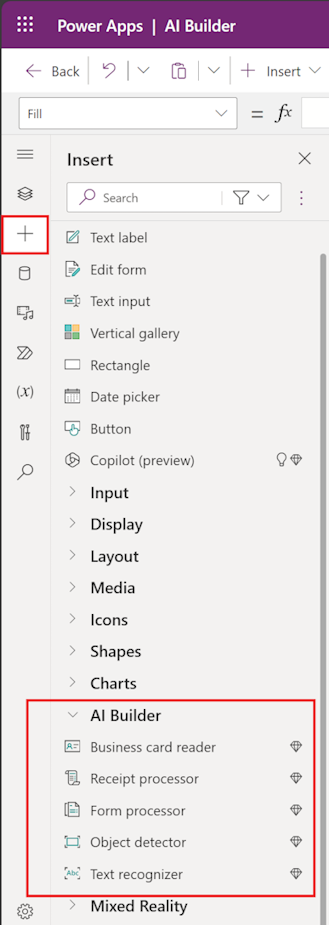Microsoft changed how Power Apps works by adding AI features that let you talk to the computer instead of clicking through menus. The May 2025 feature update introduced major improvements to AI Builder integration. It's pretty cool when it works, but don't expect miracles.

Plans: AI That Actually Plans Stuff
Plans is Microsoft's attempt to make an AI that can design entire solutions for you. You describe what you need, and it tries to figure out all the moving parts - Power Apps, Power BI, Power Pages, the whole ecosystem.
The process mapping agent (still in preview as of September 2025) takes your business requirements and draws process diagrams. Sometimes they're actually useful, sometimes they look like someone had a stroke while using Visio.
Here's what I learned the hard way: Plans works great when you describe your requirements clearly. Expect to iterate 3-4 times before it gets what you actually want. The first suggestion is usually "close but not quite right," like when you ask for a CRM and it suggests 47 different tables you don't need.
Plans can generate:
- Power Apps (obviously)
- Power BI reports (that may or may not show useful data)
- Power Pages websites (basic ones work fine)
- Copilot Studio agents (if you're into that)
Copilot: Talking to Your Computer Like a Crazy Person
Copilot in Power Apps lets you build apps by describing what you want instead of dragging controls around like it's 1995. You tell it "I need a form for expense reports" and it makes one. Pretty neat until you need something specific.
What works well:
- Basic forms and galleries
- Simple data connections to Dataverse
- Standard business app layouts
- Power Fx formulas for common operations
What doesn't work so well:
- Complex business logic ("if the customer is from California but it's Tuesday...")
- Custom styling that doesn't look like every other Power App
- Performance optimization (it generates functional code, not fast code)
- Error handling (you'll need to add that yourself)
Copilot is helpful for basic apps but still generates buggy formulas for complex logic. Always test the hell out of anything it creates, especially calculations involving money or dates. The official testing guidance covers what to check for.
Generative Pages: The Shiny New Thing
Generative Pages is in early access preview and it's impressive when it works. You describe an interface or upload a wireframe, and it generates actual React code. The results are often better than what I'd drag-and-drop myself.

Reality check: This is preview software. It creates beautiful interfaces that sometimes don't actually work. The generated code looks professional but might have logic errors that only show up when real users touch it. Don't expect production-ready code without cleanup.
I've had mixed results:
- Simple dashboards: Usually work great
- Complex forms with validation: Need manual fixes
- Data entry screens: Good starting point, requires tweaking
- Reports and analytics: Hit or miss on the queries
Enhanced Component Properties: Finally, Reusable Stuff
Enhanced Component Properties went GA and now you can actually build component libraries that don't suck. You can pass both data and functions to components, which should have been possible from day one.
This is genuinely useful if you're building multiple apps that need similar functionality. Create your components once, use them everywhere, and when you fix a bug, it's fixed everywhere. Revolutionary stuff for 2025.
Custom AI Models: Expensive But Powerful
Power Apps supports custom AI models from Azure AI Foundry now. You get access to thousands of models including GPT-4, Llama, and whatever else Microsoft licenses this month.
This sounds cool until you see the Azure bills. Custom AI models aren't cheap, and they burn through credits faster than you'd expect. Unless you have specific domain expertise that standard models can't handle, stick with the built-in AI features.
Agent Supervision: Babysitting Robots
The Agent Feed feature lets humans supervise AI agents in model-driven apps. It's like watching a robot do work and stepping in when it gets confused.
Useful for scenarios where AI can handle 80% of the work but humans need to catch the edge cases. Works well for document processing, customer service routing, and data validation workflows.
Real Talk About Pricing (September 2025)
Power Apps Premium: $20/user/month
- 500 AI Builder credits (burn through these fast if you're doing serious document processing)
- That $20 quickly becomes $50+ when you add up all the Azure services you actually need
AI Builder Add-ons: $500/month per million credits
- Keep an eye on your credits because they disappear fast and Microsoft will happily charge you $500/month for more
Enterprise: $12/user/month with 2,000+ seats
- Sounds good until you realize you need 12 different licenses to make everything work
What Actually Works in Production
I've been testing these features since the previews started. Here's what I'd actually use:
Use This Stuff:
- Plans for initial solution architecture (saves hours of requirements gathering)
- Copilot for basic app generation (good starting point)
- Enhanced components (should have existed years ago)
- Agent supervision for semi-automated workflows
Maybe Use This:
- Generative Pages (when it leaves preview and gets more stable)
- Custom AI models (if you have deep pockets and specific needs)
Skip For Now:
- Anything marked "preview" for production workloads
- Custom AI models unless you have a specific use case worth the cost
The learning curve isn't technical skills - it's learning how to talk to the AI without confusing it. Expect to spend 2-3 weeks figuring out how to describe requirements clearly enough for the AI to understand. Microsoft's prompt engineering documentation actually helps with this part.
